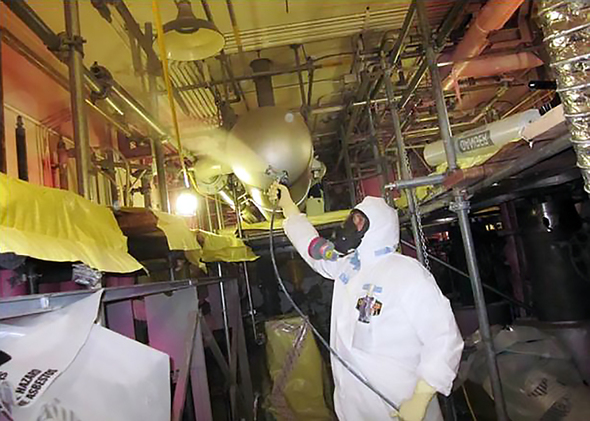WASHINGTON, D.C. – EM is taking steps to collect lessons learned and best practices in the Cold War cleanup gained through the experience of its workforce.
EM joined a collaborative effort that is making these resources available on the Deactivation and Decommissioning Knowledge Management Information Tool (D&D KM-IT), a public, web-based knowledge management information system for the D&D community.
The tool contains D&D knowledge and expertise gained over the years by DOE employees and contractors. Their valuable information is collected, consolidated and shared on D&D KM-IT, a universally available and usable system that provides a single point of access to the collective knowledge base of the D&D community within and outside of DOE.
“Members of our highly trained D&D workforce continually acquire specialized skills with each project. They understand that carefully engineered and executed D&D activities must address the reality that D&D cleanup projects are extremely dynamic, requiring innovative approaches. These workplace experiences will provide valuable knowledge to the D&D workforce of today and tomorrow,” D&D KM-IT EM Project Lead John De Gregory said.
The lessons and practices focus on topics such as D&D of reactors at Argonne National Laboratory in Illinois and the Savannah River Site in South Carolina; managing a buried waste exhumation project at the Idaho site; and demolishing a research facility building at Lawrence Livermore National Laboratory in California.
EM collaborated on this project with Florida International University (FIU) and two former EM centers that collected these lessons and practices. The EM As Low As Reasonably Achievable (ALARA) centers at EM’s Hanford and Savannah River sites closed due to budget constraints in recent years. They had assisted EM employees with new tools and work practices.
“The preservation and sharing of experiences, lessons learned and best practices within DOE and other D&D communities reduces the need to rediscover past knowledge while capturing new information. This information enhances the outcomes for worker safety and schedule efficiencies and leads to a reduction of technical risk for our D&D projects now and in the future,” De Gregory said.

This photo is included in a report that discusses worker protective suits. The report is part of the lessons learned, best practices and other guidance now featured in the Deactivation and Decommissioning Knowledge Management Information Tool. The worker pictured, an insulator, is wearing a protective suit designed to fit better around the respirator and allow for improved breathing.
The D&D KM-IT website now contains information updates and activity reports from the former ALARA centers from 2003 to 2011. The tool preserves this valuable knowledge, allowing specific information to be found easily through a search tool, and disseminates the data as needed to the D&D community. Users can search for updates and reports by keyword or phrase.
The lessons learned can be accessed here and the best practices can be found here.
EM encourages members of the D&D community to post additional lessons and practices to the website. Instructions for uploading these documents can be found on the website’s help page.
In a related development, EM added two new guidance documents to D&D KM-IT that were developed to govern structural and electrical design and optimize safe and cost-effective approaches in the D&D phases. These best practices help fill the need for engineering standards for construction, addressing unique situations arising in D&D activities.
The guidance in these documents has been implemented at the Idaho National Laboratory over the past six years and has yielded hundreds of thousands of dollars in cost savings and allowed for infrastructure to be installed more efficiently. There have been no adverse safety effects as a result of following this guidance.
The documents, which provide structural and electrical code guidance for D&D activities at DOE facilities, are also available at the Energy Facility Contractors Group (EFCOG) website.
The D&D KM-IT was developed by the Applied Research Center at FIU in collaboration with EM, EFCOG and the former ALARA centers. For additional information, contact Dr. Leonel Lagos at (305) 348-1810 or lagosl@fiu.edu.